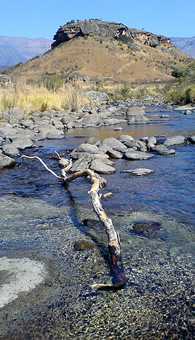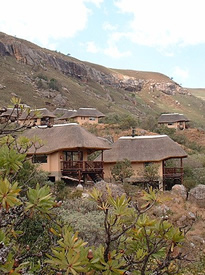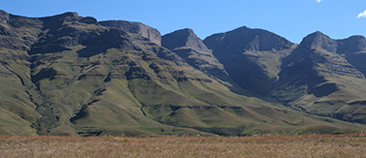Drakensberg: Giant’s Castle Game Reserve
 Giant’s Castle Game Reserve
Giant’s Castle Game Reserve
Continuing on with the theme of gracious accommodation and civilized pursuits, I am returning to the Drakensberg, and this time to Giants Castle Game Reserve. As with the Royal Natal National Park, and Cathedral Peak, the dominant themes here are walking, climbing and horse riding, with the usual emphasis on bird-watching and gorgeous seasonal floral displays. Also, of course, there is the celebrated vista, which differs within the Giant’s Castle Game Reserve only inasmuch as it is characterised this time by a grassy plateau among deep river valleys pressed up against the sheer cliffs of the escarpment.
Again the walking trails allow for the participation of just about anyone from the very occasional stroller to the maniac death marcher. For the sake of the latter there is a magnificent contoured trail that runs from south to north, pressed tight up against the escarpment, and continuing up almost the entire length of the reserve. On a clear day, and sometimes even on a cloudy day, this trail offers sweeping views of the diminishing perspective of foothills that run, it seems at times, into the deepest blue infinity.
For the rest of us there are about 285kms of varied footpaths that traverse the reserve with the two main focus’ tending to be in the south and the north. Scattered around the reserve there are four mountain huts as well as a handful of caves that are suitable for overnight camping. The huts are equipped with bunks, a gas stove, cooking oddments and a flush toilet. Reservations for both caves and huts should be made with the Officer-in-Charge of the reserve.
How To Get There
There are two main routes into the reserve, north and south, the first being to the Injisuthi Camp to the north via the 331 from Loskop (a dorp with the lovely name, translating from the Afrikaans as Loose Head, or Space Cadet in contemporary parlance) which is reached via either Winterton or Ennersdale, both off the N3 near Estcourt. The second route in is through the Witteberg Gate via the 391 from Mooiriver/Nottingham Road, also off the N3. Here you will find the main KNZ Wildlife Office, and the Giant’s Castle Main Camp.
What To Expect
Simple but beautifully situated thatch cottages are available at Main Camp to which your own food and basic supplies have to be brought. The camp is laid out in a village type configuration with 37 units ranging from 4 to 6 beds, with one known as Brides Bush that has a double bed and somewhat of a private setting. Hutted accommodation, meanwhile, is also available at Injisuthi Camp in the north, with both camps offering good camp site facilities.
 A comprehensive network of trails lead of from both camps in varying directions, and all the main and secondary trails more or less start from these two points. Most trails are adequately signposted, although it definitely makes sense if you are planning several nights out, or a traverse of the escarpment, to bring along a topographical map and a GPS, the former being available at any KNZ Wildlife office, and in this instance the relevant edition being Map 3 in the series covering Injisuthi to Highmoor. These are excellent maps that feature clearly defined trail markings with all the main huts and caves clearly indicated. You don’t really need one unless you plan to strike out some distance, but if your do you do> It is not unheard of for the lesser used trails to be poorly defined, and although getting hopelessly lost is unlikely, finding yourself severely inconvenienced for a long time is not that difficult to achieve.
A comprehensive network of trails lead of from both camps in varying directions, and all the main and secondary trails more or less start from these two points. Most trails are adequately signposted, although it definitely makes sense if you are planning several nights out, or a traverse of the escarpment, to bring along a topographical map and a GPS, the former being available at any KNZ Wildlife office, and in this instance the relevant edition being Map 3 in the series covering Injisuthi to Highmoor. These are excellent maps that feature clearly defined trail markings with all the main huts and caves clearly indicated. You don’t really need one unless you plan to strike out some distance, but if your do you do> It is not unheard of for the lesser used trails to be poorly defined, and although getting hopelessly lost is unlikely, finding yourself severely inconvenienced for a long time is not that difficult to achieve.
If you intend to make your way up to the escarpment then it is probably worthwhile planning your access to the park via Main Camp, from where the three main trails leading up towards the main face kick off. These are the Bannerman Trail, Giants Ridge/Langalibalele Ridge and Oribi Ridge, all of which meet the contour path at some point, and each of which leads to the escarpment via a pass. Choose Langalibalele Pass if you can, since it is the easiest, but also because it follows a steep but lovely trail up the Bushman’s River before you break out onto the escarpment. Few of the passes that access the escarpment can be described as easy, although some are definitely easier than others.
What To Look Out For
A sight to look out for on the trail is the rare and endangered Bearded Vulture, which is something of the signature bird of the Drakensberg. This odd creature can quite unexpectedly at times appear riding the thermals, to glance down at you curiously, so close on occasions that it seems you can reach up and tickle his chin. There is a dedicated hide that can be booked at the main office, which is worth it if you want to see this creature, and others of the 170 or so avian species that can be seen in the reserve. There is a stuffed specimen at the Royal Natal KNZ Wildlife Office, which, if you don’t see a live one, might be your only option
 Among other surprises and oddities in the reserve, you can expect to see Eland, which is a rarity in a lot of parks, but here they thrive, and are evident in strong numbers. They are a secretive animal, perhaps the largest antelope in Africa, and despite their size they are well adapted to life in the mountains. At a glance a herd looks just like a scattering of boulders across a grass plain, and usually in the Drakensberg they will not bolt as you approach, so a good look at them at close quarters is almost always possible.
Among other surprises and oddities in the reserve, you can expect to see Eland, which is a rarity in a lot of parks, but here they thrive, and are evident in strong numbers. They are a secretive animal, perhaps the largest antelope in Africa, and despite their size they are well adapted to life in the mountains. At a glance a herd looks just like a scattering of boulders across a grass plain, and usually in the Drakensberg they will not bolt as you approach, so a good look at them at close quarters is almost always possible.
In addition to this Giant’s Castle is undeniably the best region of the Drakensberg to take in the local proliferation of Bushman, or San cave art. To date more the 50 sites have been identified in the reserve with a combined compliment of more than 5 000 individual paintings. Considering the concentrations and quality of work, it has been suggested that Giant’s Castle is one of the richest areas of primitive cave art in the world. There is a great museum dedicated to the subject at Main Caves just a short walk up from Main Camp. There a display and a tour are available to lend some insight into this very unique feature of the Drakensberg. In this cave alone there are to be found more than 540 individual paintings, all of which is definitely worth checking out if you can.
An Angler’s Haven
A peripheral activity in the Berg which is not automatically associated with Africa is fly fishing, and the rivers adjacent to both Main and Injisuthi Camps are stocked with trout, and for a very modest fee a day of quite acceptable angling is available to those with an inclination.
In and Around the Area
In the vicinity of the reserve there are a number of B&B accommodation options, but look out in particular for Antbear Guest House, Wild Berry and Halls Country House. It is also worth remembering that the Drakensberg is on the Midlands Meander Route, which, as the name implies, is a route through the scenic regions of the SA midlands, featuring the Drakensberg, and lots of great cultural and gastronomic additions thereof.
For FAQ, technical info and terms and conditions for entering the park check out the KNZ Wildlife site, or the Royal Natal National Park post..
Pictures: Thanks to Flickr